

New research finds rapid evolution in plants to resist predatory insects. Rapid upper ocean warming linked to declining aerosols. They partly attribute the observed warming, and preceding cooling trends to ocean circulation changes induced by global greenhouse gas emissions and aerosols predominantly generated in the Northern Hemisphere from human activity.
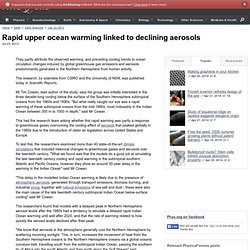
Solar radiation management. Removing trees from snowy landscapes can help reflect more sunlight into space[1] at latitudes that have meaningful incoming solar energy in the winter.
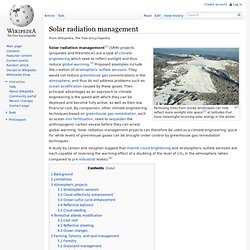
The Great Green Wall of Africa. A Science of Cities, at Long Last. Cities, it seemed, had been abandoned by science.

When all the other disciplines and systems were being quantified and theorized, cities were largely ignored. Study Finds Plant Growth Surges as CO2 Levels Rise. By Tim Radford, Climate News Network LONDON – Australian scientists have solved one piece of the climate puzzle.
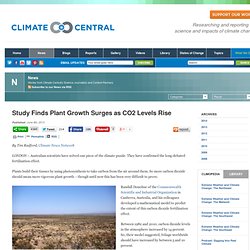
They have confirmed the long-debated fertilization effect. Plants build their tissues by using photosynthesis to take carbon from the air around them. So more carbon dioxide should mean more vigorous plant growth – though until now this has been very difficult to prove. Arid areas could be transformed by green plants as carbon dioxide levels rise. If the world lived in a single city. Global warming caused by chlorofluorocarbons, not carbon dioxide, new study says. 16:10, Space & Earth/Earth Sciences Chlorofluorocarbons are to blame for global warming since the 1970s and not carbon dioxide, according to new research from the University of Waterloo published in the International Journal of Modern Physics B this week.

Global Model Confirms: Cool Roofs Can Offset Carb. News Release Can light-colored rooftops and roads really curb carbon emissions and combat global climate change?
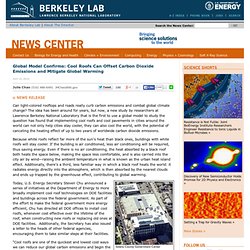
The idea has been around for years, but now, a new study by researchers at Lawrence Berkeley National Laboratory that is the first to use a global model to study the question has found that implementing cool roofs and cool pavements in cities around the world can not only help cities stay cooler, they can also cool the world, with the potential of canceling the heating effect of up to two years of worldwide carbon dioxide emissions. Because white roofs reflect far more of the sun’s heat than black ones, buildings with white roofs will stay cooler. If the building is air conditioned, less air conditioning will be required, thus saving energy. Today, U.S. “Cool roofs are one of the quickest and lowest cost ways we can reduce our global carbon emissions and begin the hard work of slowing climate change,” said Chu. Volcanoes, Not Pollution, Slow Global Warming : ImaGeo. An astronaut aboard the International Space Station captured this dramatic photograph of Sarychev Volcano in an early stage of eruption on June 12, 2009.

The volcano is in the Kuril Islands, northeast of Japan. (Photo: NASA Earth Observatory) Researchers: Volcanic eruptions offset recent global warming. Warming Climate Yields Another Hot January: NOAA. January of 2013 continued the unbroken string of months with above-average global surface temperatures, tying with 1995 as the ninth-warmest such month on record since instrument records began in 1880, the National Oceanic and Atmospheric Administration (NOAA) said on Thursday.

Life has been discovered beneath the Antarctic ice. Well, for one, much of what we know of early-Earth conditions is still primarily theoretical.
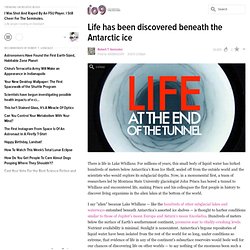
It's still very likely that we don't have anything near a complete picture of what life needs to start. For two, don't assume we are the only kind of life in existence. Just because a biosphere could never have supported us, does not mean it cannot support any kind of life. Desert bacteria could help boost crop yields. [CAIRO] Desert soil microbes could help halt desertification and boost agriculture in arid regions of the Middle East and North Africa, according to a study.

Scientists from the United Arab Emirates [UAE] have isolated local salt- and drought-tolerant strains of Rhizobia, soil bacteria that fix nitrogen when they become established inside the root nodules of legumes. Rhizobia bacteria establish a mutually beneficial relationship with their host plant in which they exchange nitrogen they fix for nutrients plants produce through photosynthesis, and could be integral to improving the quality and nitrogen content of soil. "The project was conceived when I noticed, at a research farm in Dubai, some leguminous crops forming nodules to fix atmospheric nitrogen," lead author Nanduri Rao, a researcher at ICBA, tells SciDev.Net.
Some of this work was published in PLOS ONE in October. Link to full study in Emirates Journal of Food and Agriculture Link to PLOS ONE study. California Irrigation Changing Weather Patterns in American Southwest. Arctic continues to break records in 2012: Becoming warmer, greener region with record losses of summer sea ice and late spring snow. December 5, 2012 Difference from average temperature in the Arctic from 2001-2011 compared to the long-term average (1971-2000).
Download on Climate.gov. (Credit: NOAA) The Arctic region continued to break records in 2012—among them the loss of summer sea ice, spring snow cover, and melting of the Greenland ice sheet. This was true even though air temperatures in the Arctic were unremarkable relative to the last decade, according to a new report released today. Amplified Greenhouse Effect Shifts North's Growing Seasons.
Amplified Greenhouse Effect Shifts North's Growing Seasons Vegetation growth at Earth's northern latitudes increasingly resembles lusher latitudes to the south, according to a NASA-funded study based on a 30-year record of land surface and newly improved satellite data sets. An international team of university and NASA scientists examined the relationship between changes in surface temperature and vegetation growth from 45 degrees north latitude to the Arctic Ocean.
Results show temperature and vegetation growth at northern latitudes now resemble those found 4 degrees to 6 degrees of latitude farther south as recently as 1982. "Higher northern latitudes are getting warmer, Arctic sea ice and the duration of snow cover are diminishing, the growing season is getting longer and plants are growing more," said Ranga Myneni of Boston University's Department of Earth and Environment.
The study was published Sunday, March 10, in the journal Nature Climate Change. Related Links. Robots to Repair Reefs. Scotland may not be the first place that comes to mind when you think of coral reefs, but the deep waters west of the nation are indeed home to reefs not unlike those found in the tropics. Unfortunately, a commercial fishing technique known as bottom trawling regularly damages that coral, putting the reefs at risk.